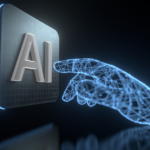Artificial Intelligence (AI) has emerged as a revolutionary force in today’s business landscape. This technology is no longer just science fiction; it’s part of our daily lives.
Despite its multiple applications, people often perceive creating artificial intelligence as challenging or mysterious. Many business owners view AI development as complex, accessible only to experts in algorithms and programming.
However, forging an AI is less overwhelming than it may appear. With the resources and support we’ll provide, you can achieve it. Whether you choose to develop your own AI or hire professionals to assist you, this process will always be within your reach.
In this guide, we not only explore how to create an AI, but we also assist you in gaining a better understanding of how to develop an AI and provide guidance on selecting the appropriate team of experts to create an effective solution for your company. Vanguard-X resources and skilled talent are at your disposal. So, keep reading to learn more!
AI Demystified

AI has been popular not only in the business world but also in technology. Wondering what AI means? AI is a field of computer science that focuses on developing systems capable of executing tasks typically delegated to humans.
Examples of these tasks include:
- Natural language and conversation
- Pattern recognition in a data set
- Problem-solving based on data
- Data-driven decision-making
There are seven types of AI. Let’s delve into them:
- Artificial Narrow Intelligence (ANI): It’s programmed to perform particular tasks but can’t learn on its own.
- Artificial General Intelligence (AGI): AGI is an AI that can do human tasks, like thinking or learning.
- Artificial Superintelligence: This AI is exceptional because it outperforms human knowledge and abilities.
- Reactive Machines: This unique AI can react quickly to things happening around it, but it can’t remember or save information for later.
- Limited Memory: It’s a type of AI with the ability to keep information and use it in order to improve its performance in future assignments.
- Theory of Mind: It’s an AI that can detect and react to human emotions while also carrying out tasks similar to those of machines with limited memory.
- Self-aware: This AI excels in identifying emotions in others. It possesses self-awareness and has the potential to achieve human intelligence.
AI in diverse industries has seen countless applications across various forms. For instance, AI has revolutionized customer service with chatbots and virtual assistants. These AI-powered tools efficiently handle multiple queries, delivering prompt responses around the clock.
Chatbots use fancy language skills to talk to people like humans do, thanks to Natural Language Processing (NLP). When businesses use these programs, they make customers happier and want to come back again.
Interested in learning how to create your own AI model and use it in your business? Let’s explore that together!
Creating AI: A Step-by-Step Guide

Business owners and CEOs frequently have inquiries about developing AI. For instance, they may wonder how building an AI in-house can boost efficiency and lower costs. They might ask if hiring an expert team would be more financially beneficial as well.
We provide a step-by-step guide to help you create artificial intelligence, whether you want to do it yourself or hire a team. This will empower you to make informed decisions and improve your AI endeavors.
1. Define What Problems Your AI Will Solve
The first step in creating an AI is to define the problems it will solve in your company. In the IT industry, there are many challenges that we can face with AI.
For instance, managing vast amounts of data is a recurrent problem for small businesses and startups. Because of their volume, they often struggle to process, analyze, and have insights from this data. AI and machine learning (ML) algorithms can help them analyze large datasets quickly and accurately.
It’s important to define the objectives and scope of AI in your business once you’ve identified the problem it will solve.
If you’re a cybersecurity expert at a startup, consider mobile app development services for better data management. Here, your goal is to improve decision-making by providing real-time analytics and insights. Also, you may want to enhance cyber threat prevention and detection.
For defining problems and goals for your AI project, we recommend you:
- Understand the limitations of your project.
- Consider the constraints posed by developing your own AI or by hiring an expert team for this task.
- Keep in mind that, in both cases, building an AI requires a significant investment in time, money, and resources.
Unlocking the potential of AI in your business or startup begins with shaping problems and goals. To succeed in your industry with AI, also define objectives, scope, and limitations.
2. Control Data Collection for Building AI
Data is the essential force of any AI system. Therefore, you must control data preparation and collection after deciding what problems your AI will solve. You also need to find high-quality data from the right places, but how can you do that?
First, identify the data you require and explore collection methods. Next, you can follow these steps:
- Gathering data: This begins when you identify sources and collect relevant data.
- Cleaning: This involves removing irrelevant, incorrect, or repeated data.
- Labeling: In the last step of the process, the AI learns the meaning of pieces of information through labeling.
Remember to ensure the quality and diversity of data in your AI training data set. Quality usually refers to how reliable or accurate the information you used to produce an AI is. Data diversity is associated with having a wide range of information.
Experts in AI software development services will tell you that considering these factors can help build an outstanding AI. If you want support, contact us.
3. Decoding the Right AI Approach
There are different techniques, each with unique capabilities and uses. With ML, AI can learn from data and improve over time without explicit programming. We can also analyze huge datasets for patterns and insights with the help of ML.
In addition, deep learning uses neural networks with many layers in order to allow you to analyze complex patterns in large amounts of data. Self-driving cars, voice-controlled assistants, and fraud detection systems are examples of deep learning.
Rule-based systems, as the name says, follow a set of predefined rules. They’re excellent with clear-cut guidelines but can’t adapt to new circumstances. Finance, banking, engineering, retail, and healthcare currently use rule-based systems for their operations.
Selecting one or more of these techniques or approaches depends on your problem and data. For example, startups can use ML to analyze customer behavior and personalize product recommendations. For fairness, startups may also need exceptional and original information to suggest things and provide exclusive deals.
Explore all choices before selecting the best way to build your AI system for your business or startup.
4. How to Build and Train Your AI
Constructing an AI model demands appropriate tools and frameworks. The initial step is designing an architecture to suit your specific problem and dataset. Preprocessing the data and using feature engineering strategies is the next crucial step.
Reprocessing involves scaling data, handling missing values, and encoding categorical variables. Feature engineering also improves AI model prediction by creating new characteristics from existing ones.
To effectively train your AI, it’s crucial to select the approach and learning algorithm. This selection should be based on your data and your reasons for creating artificial intelligence.
The last step in building and training an AI is to evaluate and improve its performance. This requires testing the model on new data and measuring its accuracy and recall. Likewise, you can adjust the model’s parameters or add more data to further evaluate and improve its architecture.
5. AI Reliability: Testing and Validating
Begin testing and validating your AI by fashioning a test set that measures its performance. To ensure accuracy in predicting unobserved data, set aside data during training.
Now that you have your test set, you can implement validation techniques. One method is cross-validation. This approach encompasses dividing the data into subsets and training your model on some of them while testing it on others. Cross-validating data helps ensure your AI performs well across all subsets rather than just a single set.
Remember that testing and validation aren’t just one-time activities. You should include them in an iterative process where you permanently evaluate your AI results. Include a feedback loop that comprehends:
- Training your AI
- Testing it
- Analyzing results
- Making adjustments
- Repeating the process until you achieve the desired performance
Are you curious to witness the power of AI in action? Let’s discover its wonders together!
6. AI in Action: Deployment and Integration
Deploying and integrating AI involves:
- Model preparation
- Environment selection
- Integration into the desired system or application
On preparation, model optimization aims to reduce complexity without sacrificing predictive power. Model conversion ensures compatibility with different environments that may need specific model formats.
Choosing environments for deployment depends on the specific requirements of your applications. You can choose between cloud-based deployments — popular for their scalability and ease of access — and edge devices, such as smartphones or IoT.
A lucid comprehension of your target system and application is imperative while integrating your AI. This stage sets up how to communicate with the AI model through protocols, data formats, and APIs.
7. Monitoring and Maintaining Your AI
As your AI strengthens and grows, it will be important to:
- Establish robust monitoring mechanisms to evaluate its performance
- Ensure effectiveness
- Identify issues
- Enable continuous improvements.
You can use these techniques to track and assess your AI performance:
- Automated monitoring systems: These systems collect performance data and generate alerts when exceeding predefined thresholds. What is the purpose of these alerts? They help you find anomalies, such as sudden accuracy drops or abrupt prediction pattern changes. With this information, you can address potential problems in time.
- Visualization tools: You can use these tools to have an overview of your AI model’s performance. The visualization of your AI will be based on specific metrics, such as confusion matrices and precision-recall curves. You and your expert team will understand the strengths and weaknesses of the AI model and also decide based on data.
- Statistical techniques: You can analyze AI performance and test hypotheses with these techniques.
Maintaining differs from monitoring your AI. It involves unique measures to make sure that your AI is effective and relevant. This is significant for your business requirements, technological advances, and changing data patterns. You can create a maintenance protocol that includes the following elements:
- Roles and responsibilities
- Update cycles
- Testing and validation
While maintaining your AI, don’t forget to address ethical considerations and biases that may affect its performance.
Why? Typically, AI models show biases in the data they were trained on, leading to negative incomes.
One way to promote the ethical use of AI is to implement strategies, protocols, and practices that mitigate risks. We can achieve this by diversifying data, addressing biases, and improving transparency.
Staff Augmentation: Hiring Experts for Developing Your AI

As we mentioned before, you have two choices: either build your own AI model for your business or startup, or hire an expert team.
Developing AI requires a skilled team that can handle the intricacies of this technology. IT staff augmentation services help you find skilled and collaborative professionals for your AI projects.
What are the benefits of hiring an AI professional team via staff augmentation services? Here is what you can expect:
- Cost-efficiency: Building in-house experts can be expensive, and you can avoid hiring costs via staff augmentation. Also, you hire professionals on a project basis, securing cost efficiency.
- Flexibility and scalability: Staff augmentation enables scalable expansion of your AI team. You can seamlessly add members as required, following an agile approach.
- Access to expertise: You can access a range of skilled professionals for AI development via staff augmentation.
If you’re considering this option, we recommend clearly defining your project requirements and looking for a reputable staff augmentation partner, like Vanguard-X, with experience in software development services.
Conclusion
If you’re looking to make an AI, whether independently or with the help of a skilled team, the steps outlined in this article will result helpful. These steps include development, monitoring, maintenance, and ethical oversight.
Feel free to reach out to us if you’re interested in building an AI for your company or startup with expert help. Our nearshore development services are available to provide you with the support you need.
FAQ
What level of programming expertise is required to create an AI?
Creating an AI requires a solid understanding of programming languages, such as Python or R.
To create an AI, you should have knowledge of data structures, algorithms, and software development principles.
Do I need a large dataset to train an AI model?
The size of a dataset depends on the complexity of the AI tasks. You can train AI models with smaller datasets using transfer learning or data augmentation.
Can I use pre-existing AI models or frameworks for my project?
Yes. TensorFlow or PyTorch provides you with predetermined tools and models you can adapt to your AI project creation’s needs. This will save you time, resources, and effort.
What are some common challenges in training AI models?
Challenges in AI training include biased data, over-fitting, underfitting, choosing structures, and managing resources.
How long does it take to create an AI?
The time to develop an AI model depends on project details, complexity, budget, resources, and team skills.
Can I create an AI without extensive computational resources?
Yes. You can use cloud platforms and services that allow you to train and deploy your AI without important hardware resources. You can use model compression and optimizations to reduce these computational resource requirements.
Is it necessary to continuously update and maintain an AI model?
Yes, because data can change significantly. Staying up-to-date with the latest trends in AI will equip you with relevant information to grow your AI. Regular monitoring, ethical considerations, biases, and bugs also make maintenance, monitoring, and updating important.











